
Introduction
Rome, the Eternal City, stands as a timeless symbol of history, culture, and civilization. Steeped in over 2,000 years of rich heritage, Rome captivates visitors with its iconic landmarks, ancient ruins, and vibrant atmosphere. From the grandeur of the Colosseum to the awe-inspiring art of the Vatican Museums, Rome offers an unparalleled journey through the epochs of human civilization. It is a city where every cobblestone street tells a story, where every piazza echoes with the footsteps of emperors and artists alike, making it a destination like no other.
As the capital of Italy and once the heart of the Roman Empire, Rome exudes an undeniable allure that draws travellers from across the globe. Beyond its historical significance, Rome enchants visitors with its lively street life, delectable cuisine, and passionate spirit. Whether wandering through the ancient ruins of the Roman Forum, tossing a coin into the Trevi Fountain, or savouring a creamy gelato on the Spanish Steps, Rome offers an immersive experience that celebrates the timeless beauty of human achievement. With its blend of ancient wonders and modern charm, Rome promises an unforgettable adventure that resonates with history, culture, and the sheer joy of exploration.
Table of Contents
Map of the Best Things to Do in Rome
The Colosseum
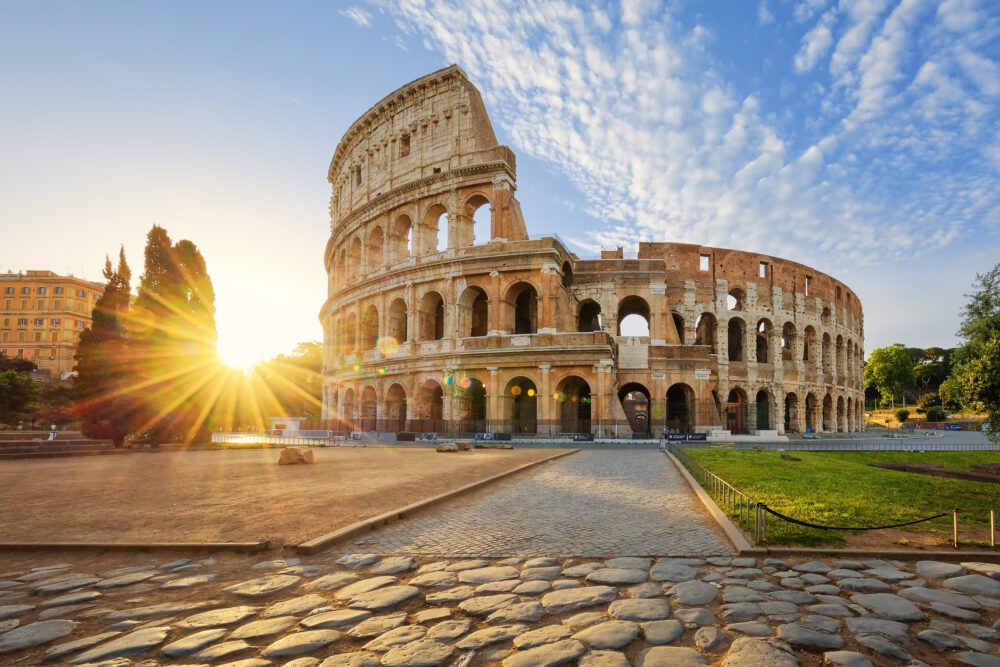
The Colosseum, also known as the Flavian Amphitheater, stands as an enduring symbol of ancient Rome’s architectural prowess and cultural significance. Built between 70-80 AD under the Flavian dynasty, this massive arena could hold up to 80,000 spectators and hosted a variety of events, including gladiatorial contests, animal hunts, and theatrical performances. Its elliptical shape and towering tiers of arches are a testament to the ingenuity of Roman engineering. Today, visitors can explore the Colosseum’s well-preserved ruins, marvelling at its grandeur while gaining insights into the spectacles that once unfolded within its walls.
To make the most of your visit to the Colosseum, it’s advisable to purchase skip-the-line tickets in advance to avoid long queues, especially during peak tourist seasons. Guided tours offer informative narratives about the history and architecture of the Colosseum, providing deeper insights into its significance. Additionally, visiting early in the morning or later in the afternoon can help avoid crowds and the scorching midday sun. After exploring the Colosseum, consider venturing to the nearby Roman Forum and Palatine Hill to complete your journey through ancient Rome’s most iconic sites.
Roman Forum and Palatine Hill

The Roman Forum and Palatine Hill, situated adjacent to the Colosseum, offer visitors a glimpse into the heart of ancient Rome’s political, religious, and social life. The Roman Forum served as the bustling center of the city, where citizens gathered for political assemblies, commercial transactions, and religious ceremonies. Over the centuries, it evolved into a sprawling complex of temples, basilicas, and government buildings, showcasing the architectural and cultural achievements of the Roman Empire. Adjacent to the Roman Forum, Palatine Hill rises majestically, known as the legendary birthplace of Rome and home to emperors and aristocrats. Exploring the ruins atop Palatine Hill offers panoramic views of the Forum below and provides insight into the lavish lifestyles of Rome’s elite.
When visiting the Roman Forum and Palatine Hill, it’s advisable to purchase a combined ticket with the Colosseum to save time and money. Guided tours offer informative narratives about the history and significance of these ancient sites, providing context to the ruins and bringing the past to life. Since these areas can be expansive and exposed to the elements, it’s recommended to wear comfortable shoes, carry water, and protect yourself from the sun. Exploring early in the morning or late afternoon can help avoid crowds and the heat of the day. Don’t miss iconic landmarks such as the Temple of Saturn, the Arch of Titus, and the House of the Vestal Virgins while immersing yourself in the rich history of ancient Rome.
Domus Aurea
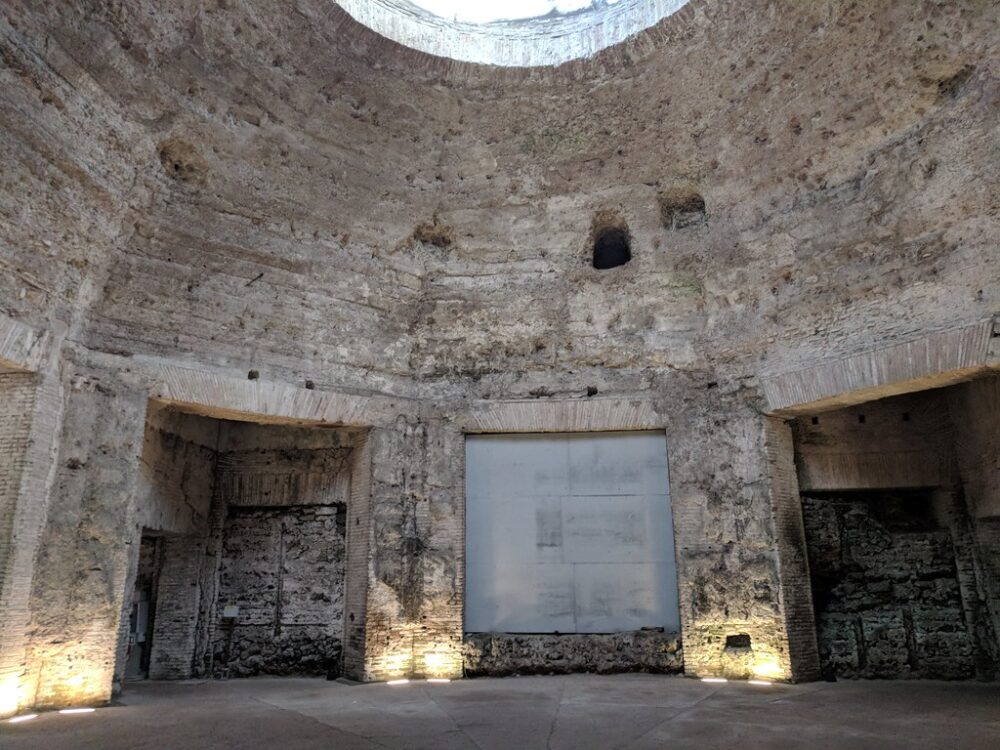
The Domus Aurea, or “Golden House,” was an extravagant palace commissioned by Emperor Nero after the Great Fire of Rome in AD 64. Situated on Oppian Hill, it was a sprawling complex with lavish gardens, opulent halls, and innovative architectural features. The palace was adorned with exquisite frescoes and adorned with precious gems and metals, reflecting Nero’s extravagant tastes. After Nero’s death, the Domus Aurea fell into disrepair and was eventually buried beneath subsequent construction. Rediscovered in the late 15th century, the palace has fascinated artists and architects for centuries, influencing Renaissance art and architecture with its innovative design and grandeur.
Visitors to Rome can now explore parts of the Domus Aurea on guided tours, offering a glimpse into the opulent lifestyle of ancient Rome’s elite. These tours provide insight into Nero’s reign and the architectural innovations of the time, showcasing the palace’s grandeur and artistic legacy. Due to ongoing restoration efforts and the delicate nature of the site, access to the Domus Aurea is limited, and advance booking is recommended. While visiting, be prepared for dim lighting conditions and wear appropriate footwear, as some areas may be uneven or slippery. Experiencing the Domus Aurea firsthand offers a unique opportunity to step back in time and marvel at the architectural splendour of ancient Rome’s Golden House.
Monument to Victor Emmanuel II
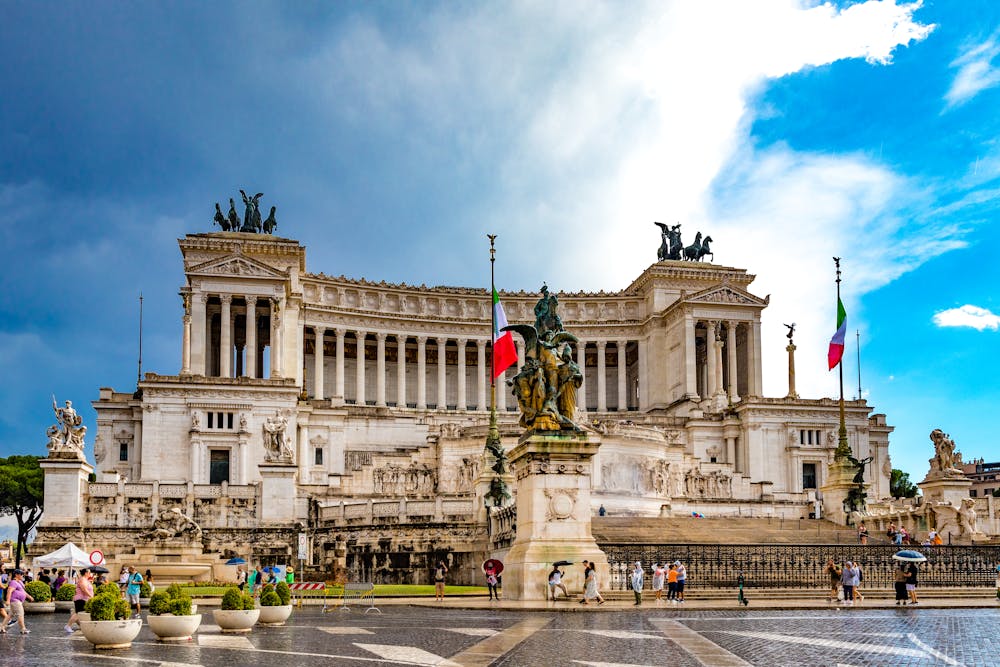
The Monument to Victor Emmanuel II, commonly known as the Altare della Patria (Altar of the Fatherland) or the Vittoriano, is a grandiose monument located in Rome’s Piazza Venezia. Built between 1885 and 1925 to honour Italy’s first king, Victor Emmanuel II, the monument is a symbol of the country’s unification and independence. Its impressive white marble facade and soaring columns make it one of Rome’s most iconic landmarks. The monument’s design incorporates various architectural styles, including Neoclassical and Baroque elements, creating a striking and monumental presence in the cityscape.
Visitors to the Vittoriano can explore the monument’s interior, which houses the Museo Centrale del Risorgimento (Central Museum of the Risorgimento) and the Tomb of the Unknown Soldier. The museum offers exhibitions and displays detailing Italy’s struggle for unification and the role of Victor Emmanuel II in the country’s history. The panoramic terrace at the top of the monument provides breathtaking views of Rome, offering visitors a unique vantage point to admire the city’s landmarks, including the Colosseum and the Roman Forum. To fully appreciate the grandeur of the Vittoriano, consider visiting during the golden hour when the sunlight bathes the monument in a warm glow, creating stunning photographic opportunities.
Trevi Fountain
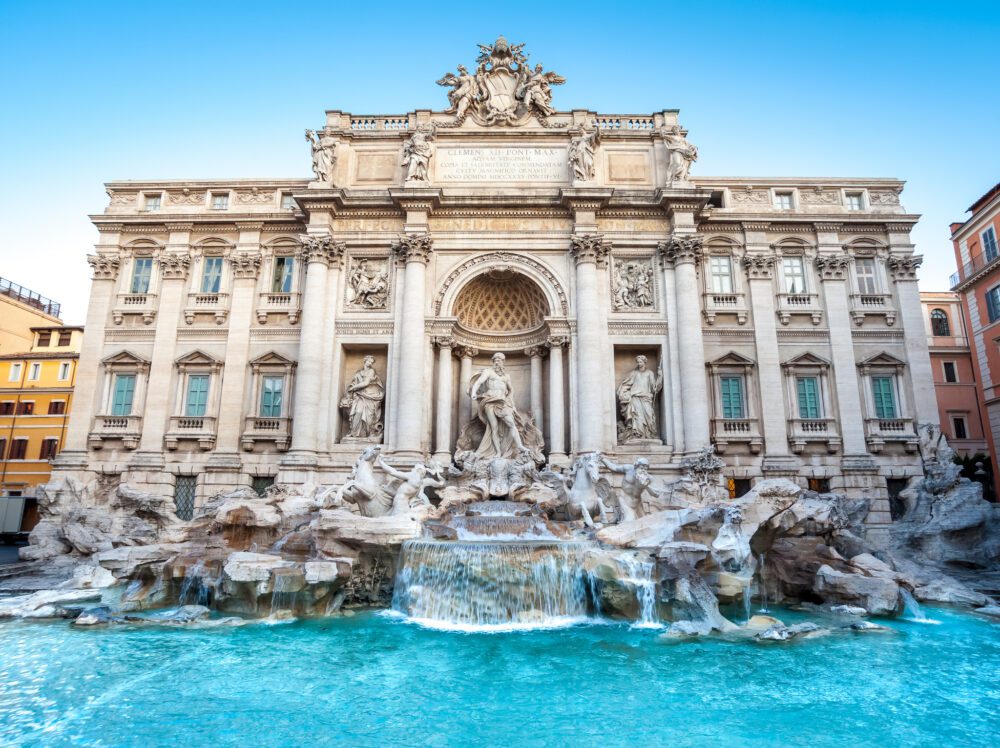
The Trevi Fountain, one of Rome’s most famous landmarks, is a magnificent Baroque masterpiece nestled in the heart of the city. Designed by architect Nicola Salvi and completed in 1762, the fountain depicts Neptune, the Roman god of the sea, riding a chariot pulled by seahorses and surrounded by Tritons and mythical creatures. Legend has it that if you toss a coin over your left shoulder into the fountain, you will ensure your return to Rome. Each day, thousands of visitors flock to the Trevi Fountain to admire its grandeur and participate in this timeless tradition, making it a bustling hub of activity and a symbol of hope and romance.
To fully appreciate the beauty of the Trevi Fountain, it’s best to visit during the quieter hours of the early morning or late evening when the crowds are thinner, allowing you to soak in the atmosphere and marvel at the fountain’s intricate details. Be sure to take some time to explore the surrounding area, which is home to charming cobblestone streets, gelaterias, and trattorias serving authentic Roman cuisine. Additionally, consider joining a guided walking tour of the Trevi Fountain and other nearby landmarks to learn more about their history and significance from knowledgeable local guides. Remember to respect the fountain and its surroundings by refraining from climbing on the sculptures or throwing anything other than coins into the water, helping to preserve this iconic symbol of Rome for future generations to enjoy.
The Pantheon

The Pantheon stands as a testament to Roman engineering prowess and architectural brilliance, dating back to around 125 AD. Originally built as a temple to honour all the gods of ancient Rome, the Pantheon boasts a massive dome with a central oculus, allowing natural light to flood the interior. This architectural marvel is renowned for its perfect proportions and innovative design, which have inspired architects for centuries. Today, the Pantheon serves as a church, dedicated to St. Mary and the Martyrs, and it remains one of the best-preserved ancient Roman buildings in the world.
Visitors to the Pantheon can marvel at its majestic dome and explore its cavernous interior, which houses the tombs of several notable figures, including the artist Raphael. Entrance to the Pantheon is free, making it accessible to all who wish to experience its grandeur. To avoid crowds, consider visiting early in the morning or later in the evening, as the Pantheon tends to be busiest during the middle of the day. After exploring the Pantheon, take some time to wander through the charming streets of the surrounding historic district, where you’ll find bustling cafes, artisan shops, and picturesque piazzas waiting to be discovered.
Piazza Navona
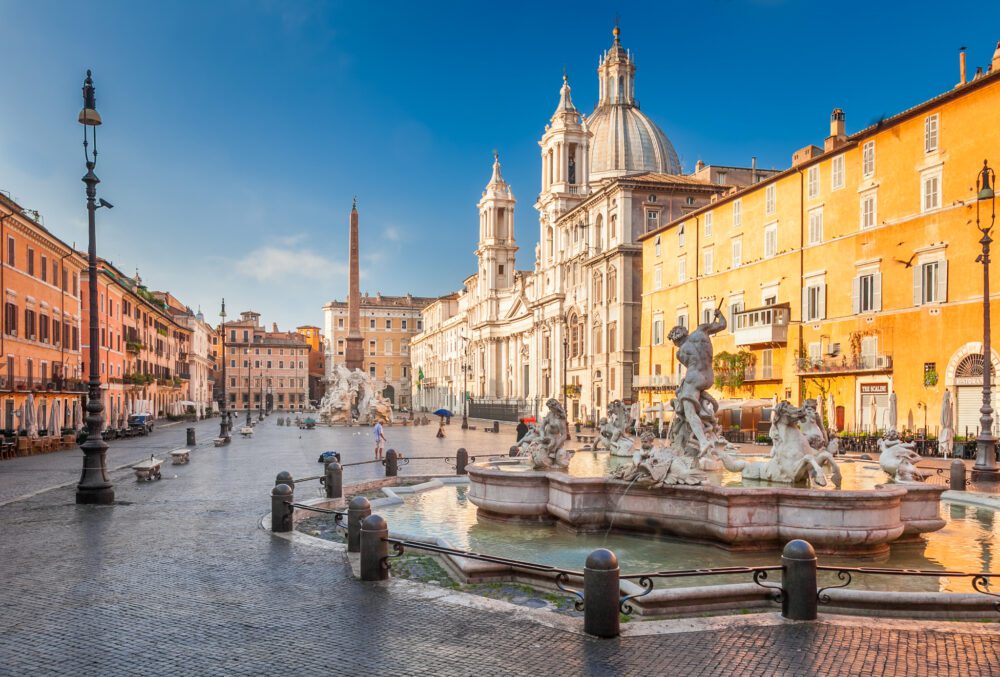
Piazza Navona stands as one of Rome’s most iconic squares, renowned for its stunning Baroque architecture and vibrant atmosphere. Originally built as a stadium by Emperor Domitian in the 1st century AD, the piazza was later transformed into a public space during the Renaissance period. Today, Piazza Navona is adorned with three magnificent fountains, the most famous being Bernini’s Fountain of the Four Rivers in the centre of the square. This masterpiece sculpture represents four major rivers from different continents and is a testament to Bernini’s artistic genius. Surrounding the square are elegant palaces, charming cafes, and street artists, creating a lively ambience that attracts visitors from around the world.
Visitors to Piazza Navona can spend hours soaking in the vibrant atmosphere, admiring the fountains, and people-watching from one of the many outdoor cafes. The square is particularly enchanting in the evening when it comes alive with twinkling lights and the sounds of street musicians. While exploring Piazza Navona, don’t miss the opportunity to sample some gelato from one of the nearby gelaterias or to browse the stalls of local artisans selling handmade crafts. Additionally, consider visiting early in the morning or later in the evening to avoid crowds, as Piazza Navona tends to be busiest during the middle of the day.
Castel Sant’Angelo
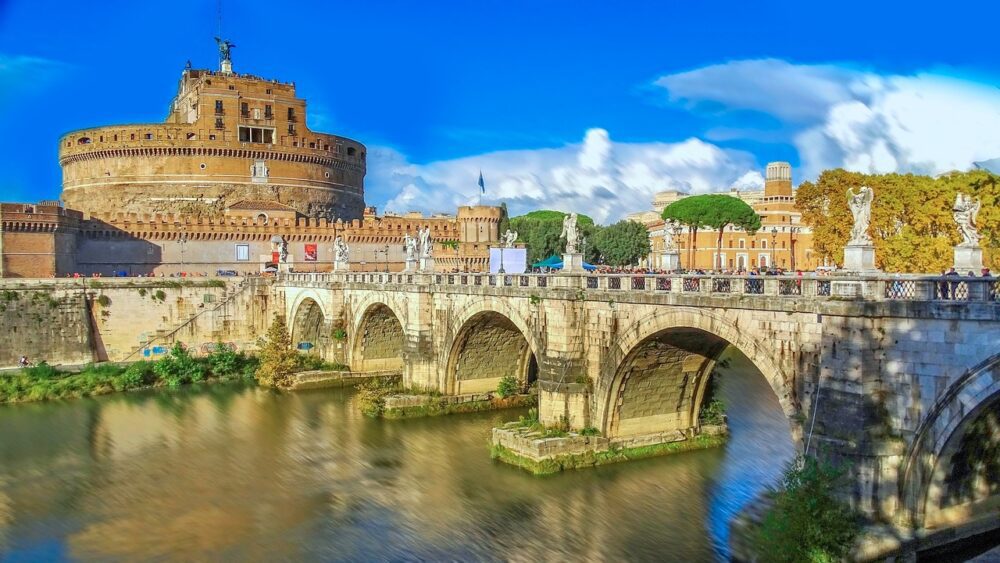
Perched majestically along the Tiber River, Castel Sant’Angelo is a historic fortress that has stood as a symbol of Rome’s rich history for over two millennia. Originally commissioned by Emperor Hadrian as a mausoleum for himself and his family in the 2nd century AD, the building was later converted into a military fortress and papal residence. One of the most intriguing aspects of Castel Sant’Angelo is its connection to the Vatican City. The castle is linked to St. Peter’s Basilica by the famous Passetto di Borgo, a secret passageway that provided a means of escape for the pope in times of danger. Over the centuries, Castel Sant’Angelo has served various purposes, from a fortress and prison to a museum housing an impressive collection of Renaissance art and medieval weaponry.
Visitors to Castel Sant’Angelo can explore its many chambers and passageways, each offering glimpses into Rome’s storied past. The castle’s rooftop terrace provides panoramic views of the cityscape, offering breathtaking vistas of landmarks such as St. Peter’s Basilica, the Vatican Museums, and the Roman Forum. It’s recommended to visit Castel Sant’Angelo during the early morning or late afternoon to avoid the crowds and to take advantage of the cooler temperatures. Additionally, guided tours are available for those who wish to delve deeper into the history and architecture of this fascinating monument.
Tiber River Cruise

A Tiber River cruise offers a unique perspective of Rome, allowing visitors to witness the city’s iconic landmarks from a different vantage point. The Tiber River has played a central role in Rome’s history, serving as a vital waterway for trade and transportation since ancient times. Today, a leisurely cruise along the river offers a relaxing way to explore the city while taking in views of historic bridges, ancient ruins, and Renaissance palaces that line its banks. Some of the notable landmarks visible from the river include the Castel Sant’Angelo, St. Peter’s Basilica, and the Vatican City.
Practical tips for enjoying a Tiber River cruise include choosing a reputable tour operator that offers informative commentary in multiple languages, ensuring that you can fully appreciate the historical significance of the sites you pass by. It’s advisable to book tickets in advance, especially during peak tourist seasons, to secure your preferred time slot and avoid long queues. Opting for a sunset cruise provides a particularly enchanting experience, as the fading light bathes Rome’s monuments in a warm, golden glow.
The Vatican Museums and Sistine Chapel
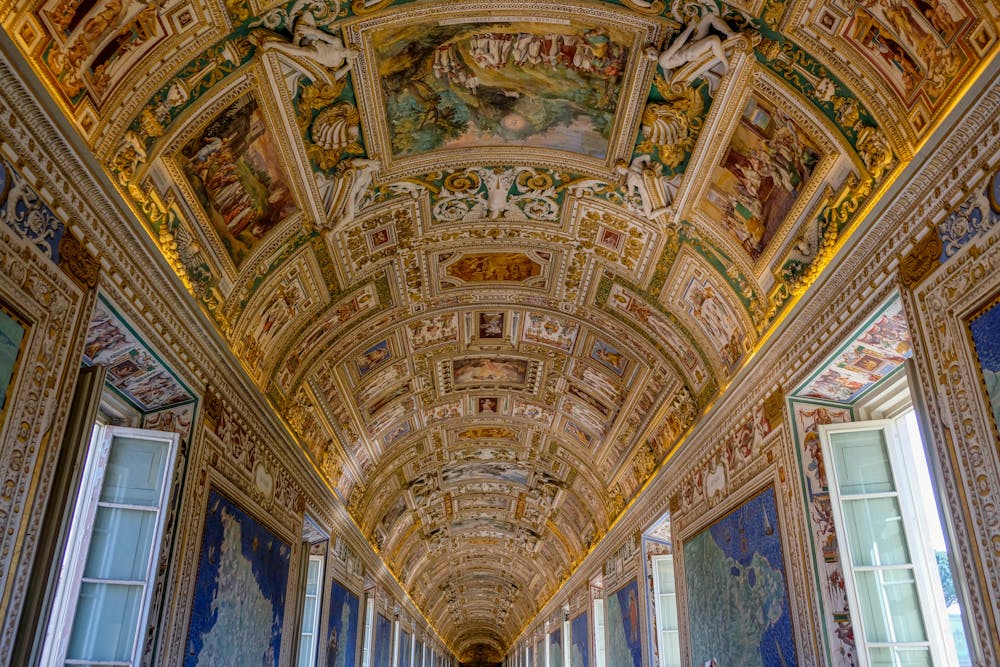
The Vatican Museums and Sistine Chapel stand as jewels of artistic and cultural heritage within Vatican City, drawing millions of visitors each year to marvel at their unparalleled collections. The museums originated from a private collection of Pope Julius II in the early 16th century and have since grown to encompass a vast array of artworks spanning centuries of human history. Visitors can explore an extensive range of galleries, showcasing classical sculptures, Renaissance masterpieces, and treasures from ancient civilizations. One of the highlights of the Vatican Museums is undoubtedly the Sistine Chapel, renowned for its breathtaking ceiling painted by Michelangelo, depicting scenes from Genesis and the Last Judgment on the altar wall.
Practical tips for visiting the Vatican Museums and Sistine Chapel include purchasing tickets in advance to skip the long queues that often form outside the entrance. Guided tours are highly recommended to gain deeper insights into the artworks and history of the museums, as well as to navigate the vast complex more efficiently. It’s advisable to dress modestly, covering shoulders and knees, as a sign of respect when visiting religious sites within the Vatican. Additionally, visitors should be prepared for crowds, especially during peak tourist seasons, and allocate sufficient time to explore the museums thoroughly.
St Peter’s Basilica

St. Peter’s Basilica, one of the most iconic landmarks in Rome, stands as a masterpiece of Renaissance architecture and a symbol of the Catholic Church’s grandeur. The basilica is built atop the site where tradition holds that St. Peter, one of the apostles of Jesus Christ and the first pope, was buried. The original basilica was constructed in the 4th century by Emperor Constantine, but the current basilica, designed by renowned architects such as Michelangelo, Bramante, and Bernini, was completed in the 17th century. Its immense dome, designed by Michelangelo, dominates the skyline of Rome and is a testament to human ingenuity and artistic brilliance. Inside the basilica, visitors are greeted by a wealth of exquisite artworks, including Michelangelo’s Pieta and Bernini’s Baldacchino, creating an awe-inspiring atmosphere that captivates all who enter.
Practical tips for visiting St. Peter’s Basilica include arriving early in the morning or late in the afternoon to avoid the crowds that flock to the basilica throughout the day. Entry to the basilica is free, but there may be long lines, especially during peak tourist seasons, so purchasing a skip-the-line ticket or joining a guided tour can save valuable time. Visitors should dress appropriately, covering shoulders and knees, as a mark of respect when entering the basilica, which is a sacred place of worship. Climbing to the top of the dome offers breathtaking views of Rome, but it requires ascending a narrow spiral staircase, so visitors should be prepared for a challenging climb. Despite the crowds and potential wait times, a visit to St. Peter’s Basilica is an unforgettable experience that provides insight into both the religious and artistic heritage of Rome.
The Spanish Steps
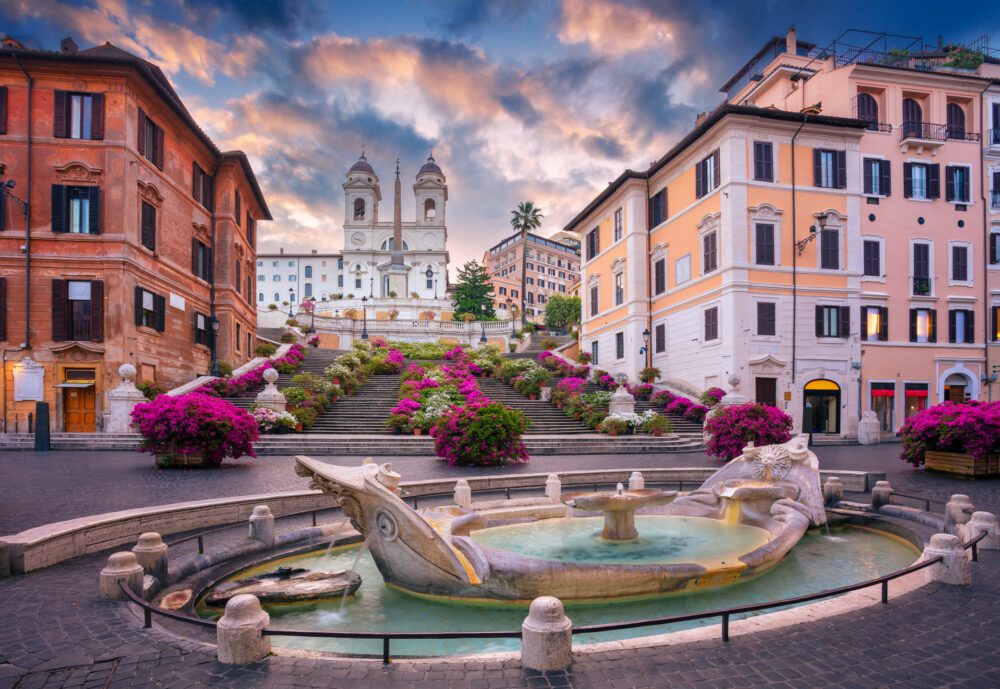
The Spanish Steps, known as Scalinata di Trinità dei Monti in Italian, is a grand staircase located in the heart of Rome, connecting the Piazza di Spagna at the base with the Trinità dei Monti church at the top. Constructed between 1723 and 1725, the Spanish Steps were designed by the architect Francesco de Sanctis and funded by French diplomat Étienne Gueffier. The name “Spanish Steps” derives from the nearby Spanish Embassy to the Holy See, which is situated in the Piazza di Spagna. The 135-step staircase is one of Rome’s most iconic landmarks and a popular gathering spot for both locals and tourists. The elegant design of the steps, adorned with azaleas in the spring and early summer, creates a picturesque setting that has inspired artists, writers, and filmmakers for centuries.
Practical tips for visiting the Spanish Steps include visiting early in the morning or late in the evening to avoid the crowds that gather during the day. The staircase can be particularly crowded during peak tourist seasons, so it’s advisable to exercise caution and be aware of pickpockets in the area. Visitors can also enjoy the vibrant atmosphere of the surrounding Piazza di Spagna, which is lined with luxury boutiques, cafes, and art galleries. Climbing the Spanish Steps provides panoramic views of the city, offering a unique perspective of Rome’s historic centre.
Villa Borghese and Gallery
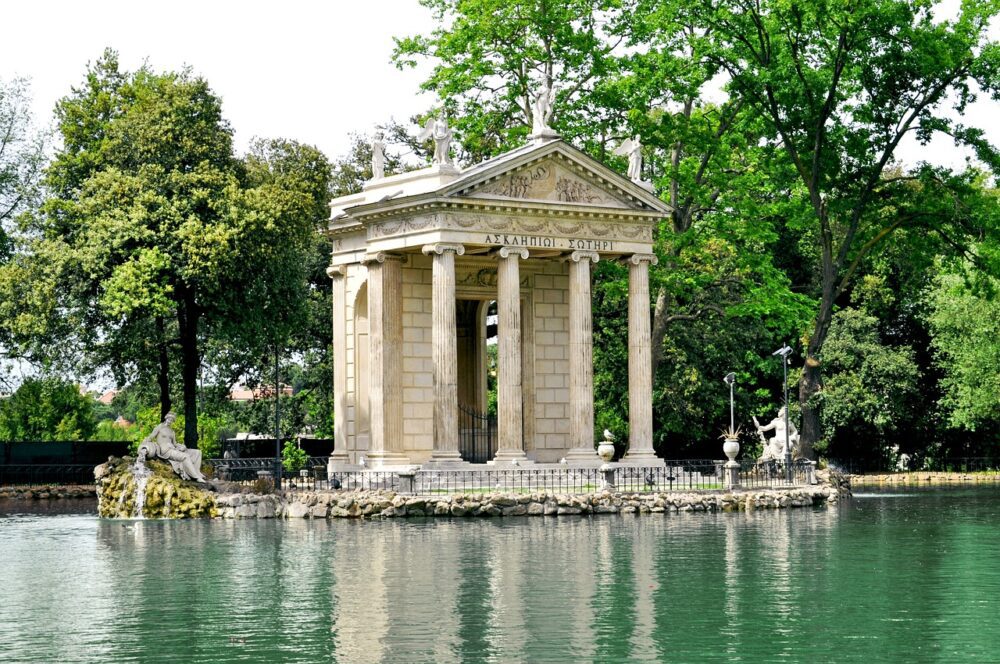
Villa Borghese is an expansive park in the heart of Rome, covering approximately 80 hectares of green space. It was originally established as a vineyard in the 16th century by Cardinal Scipione Borghese, a nephew of Pope Paul V. Over the centuries, the villa and its grounds underwent several transformations, eventually becoming a public park in the early 20th century. Today, Villa Borghese is a beloved recreational area for both locals and visitors alike, offering a serene escape from the bustling city streets. Within the park, visitors can find an array of attractions, including beautiful gardens, tranquil lakes, and picturesque walking paths.
One of the main highlights of Villa Borghese is the Galleria Borghese, an art gallery housed in the former Villa Borghese Pinciana. The gallery is renowned for its impressive collection of sculptures and paintings, including works by renowned artists such as Caravaggio, Bernini, Raphael, and Titian. Among its most famous pieces are Caravaggio’s “David with the Head of Goliath” and Bernini’s “Apollo and Daphne.” Due to its popularity, it’s advisable to book tickets in advance to ensure entry, as the gallery has a limited number of visitors allowed at any given time. After exploring the museum, visitors can take a stroll through the surrounding Villa Borghese gardens, enjoying the tranquil beauty of the landscaped grounds and perhaps even renting a rowboat to paddle on the lake. It’s a perfect retreat for art enthusiasts and nature lovers alike, offering a delightful combination of culture and relaxation in the heart of Rome.
Trastevere

Trastevere, located on the west bank of the Tiber River, is one of Rome’s most charming and atmospheric neighbourhoods. Its name, which translates to “across the Tiber,” reflects its location opposite the historic centre of Rome. Trastevere has a rich history dating back to ancient times when it was inhabited by the Etruscans before becoming a working-class district during the Roman Empire. Over the centuries, Trastevere developed its distinct character, characterized by narrow cobblestone streets, colourful buildings adorned with ivy and bougainvillaea, and lively piazzas bustling with cafes, trattorias, and artisan shops. Despite its popularity with tourists, Trastevere has managed to retain much of its authentic Roman charm, making it a favourite destination for visitors looking to experience the city’s vibrant local culture.
One of the highlights of Trastevere is its vibrant food scene, offering a diverse array of traditional Roman cuisine as well as international flavours. Visitors can wander through the neighbourhood’s narrow streets and discover cosy trattorias serving up classic dishes like cacio e pepe, carbonara, and supplì (Roman rice balls). In the evening, Trastevere comes alive with the sounds of laughter and music as locals and tourists alike gather in the neighbourhood’s lively piazzas to enjoy an aperitivo or dine al fresco. Piazza di Santa Maria in Trastevere is particularly picturesque, with its stunning Basilica di Santa Maria, which dates back to the 12th century. Visitors should also take the time to explore the neighbourhood’s hidden gems, such as the charming Villa Farnesina with its stunning frescoes and the beautiful Santa Cecilia in Trastevere church.
Rome Catacombs
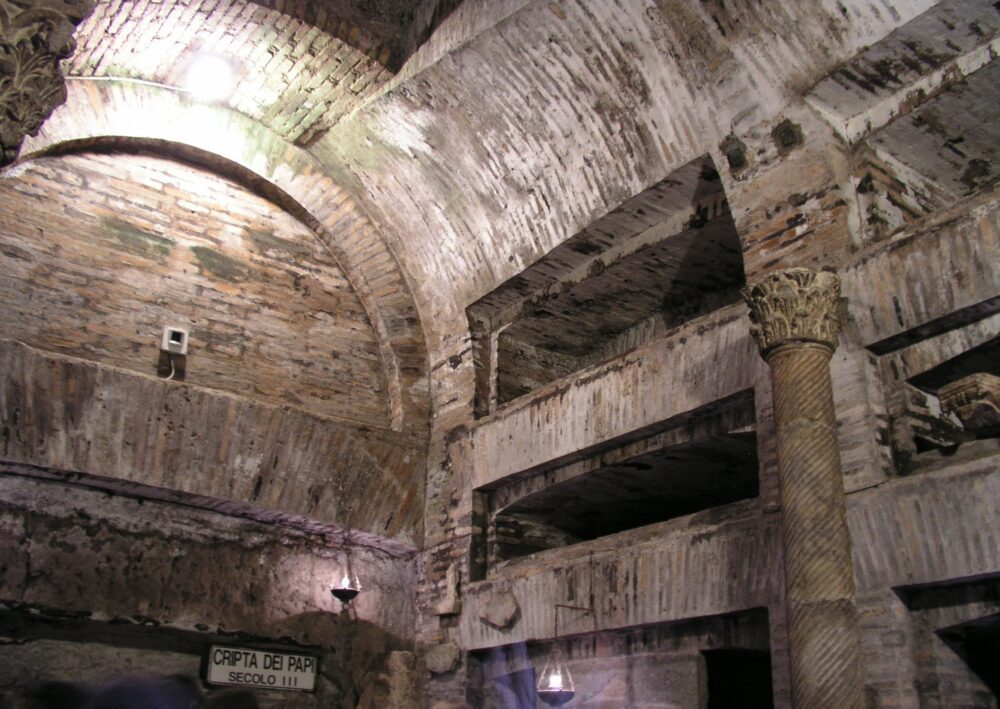
Beneath the bustling streets of Rome lies a network of ancient catacombs, offering a fascinating glimpse into the city’s early Christian history. These underground burial sites, dating back to the 2nd century AD, served as final resting places for early Christians, martyrs, and saints. The catacombs were also places of worship and refuge for persecuted Christians during times of persecution. Today, several catacombs are open to the public, allowing visitors to explore this unique aspect of Rome’s history. Among the most popular are the Catacombs of Domitilla, Catacombs of San Callisto, and Catacombs of Priscilla, each offering guided tours that delve into the history and significance of these ancient burial sites.
Visitors to the Rome catacombs should be prepared for an immersive journey into the past. Guided tours typically include visits to the underground burial chambers, where visitors can see ancient frescoes, sculptures, and inscriptions that provide insights into early Christian beliefs and practices. Practical tips for visiting the catacombs include wearing comfortable shoes and clothing suitable for walking through narrow passages and dimly lit tunnels. It’s also advisable to book guided tours in advance to secure a spot, as access to some catacombs may be limited. Additionally, visitors should be respectful of these sacred sites and follow the instructions of their guides to ensure a memorable and educational experience.
Conclusion
Exploring Rome is like stepping into a living museum, where ancient history and modern life intertwine seamlessly. From iconic landmarks like the Colosseum and Vatican City to hidden gems like Trastevere and the catacombs, Rome offers a wealth of experiences waiting to be discovered. Whether you’re drawn to the grandeur of ancient architecture, the charm of cobblestone streets, or the vibrant culture and cuisine, Rome captivates visitors with its timeless allure.
As you bid arrivederci to the Eternal City, take with you memories of its storied past, vibrant present, and the promise of future adventures. Rome’s rich history, stunning architecture, and warm hospitality ensure that every visit is a journey of discovery and wonder, leaving a lasting impression on all who have the pleasure of experiencing its beauty.
